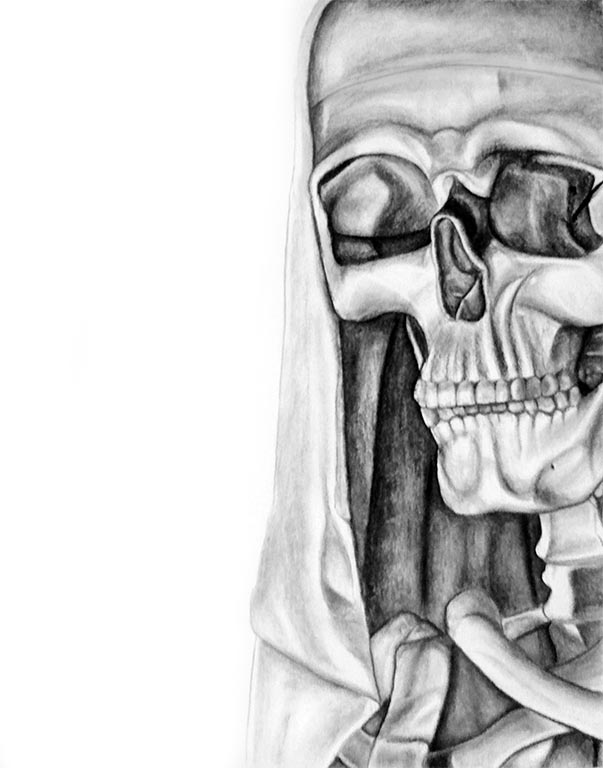
Drapery Still Life
When approaching this project, the initial idea was to create an interesting composition, with emphasis on framing. To achieve this, I found an interesting focal point on the still-life display, and zoomed in on it. The experimentation eventually amounted to my initial sketch, which found an interesting angle. With some modification to the framing, the final contour drawing represented the desired composition of the final piece. With the next stages of shading, the idea was emphasizing both depth and details.
To complement the composition, the shading needed to be consistent as well. The foreground, the face, was accented with hard lines and greater value changes exaggerated between dark shadows and highlights. The drapery was further back, and needed to be rendered as such. The contrast was much less drastic, and the lines and shading were softer. When these two varying elements of value and detail met, they created the illusion of atmospheric perspective.
The most important Gestalt Principle was form; the illusion of depth was the most important aspect to render, as the light source presented the opportunity for exaggerated shading and highlights. Secondary would be continuation. How the eye moves through the piece is directly attributed to the composition, and this must be acted upon in all stages of creation. For my piece, I made the face of the skull as a strong focal point, with shading and detail to draw the eye in. Afterwards, the softer cloth will lead the eye downwards, and into the collarbone and ribcage. Despite being asymmetrical, the piece contains balance, and the negative space further brings emphasis to the object. The decision to make this an open composition gives a sense of energy, suggesting the subject extends well beyond the boundaries of the paper.
This project combines our background in still-life drawing and figure drawing, mainly because we were drawing the skeleton of the human body in a natural pose. Our techniques for shading remained relevant, as the pieces of the skeleton could easily be broken up into geometric shapes to create a better visual. For our line of work, photorealistic understanding of human structure remains an invaluable skill to be mastered; we have furthered both our understanding of bone structure, as well as effective shading.
The critiques of my, and others’ pieces became a learning experience for bettering techniques, and even common pitfalls that one might run into. Throughout the varying compositions, I noticed that it was the emphasis of the foreground that really created a sense of unity. For my piece in particular, there was an immediate reaction; the pose and framing worked to immediately bring the object forward. In addition, it created a confrontational feeling, as it was thrust forward and rhythmically pulled the viewer in. I think my greatest successes were credited to the shading, and thus the emphasis of the pieces that I felt were most important.
The idea of a background was another concept that was varied throughout the class. Most had used it effectively to complement the piece, while not taking away attention from it. I had grappled with the idea, considering a glow around the outside of the piece, however, I had come to the conclusion amongst my peers that it ultimately wasn’t worth it, and the piece stood on its own, as is.
